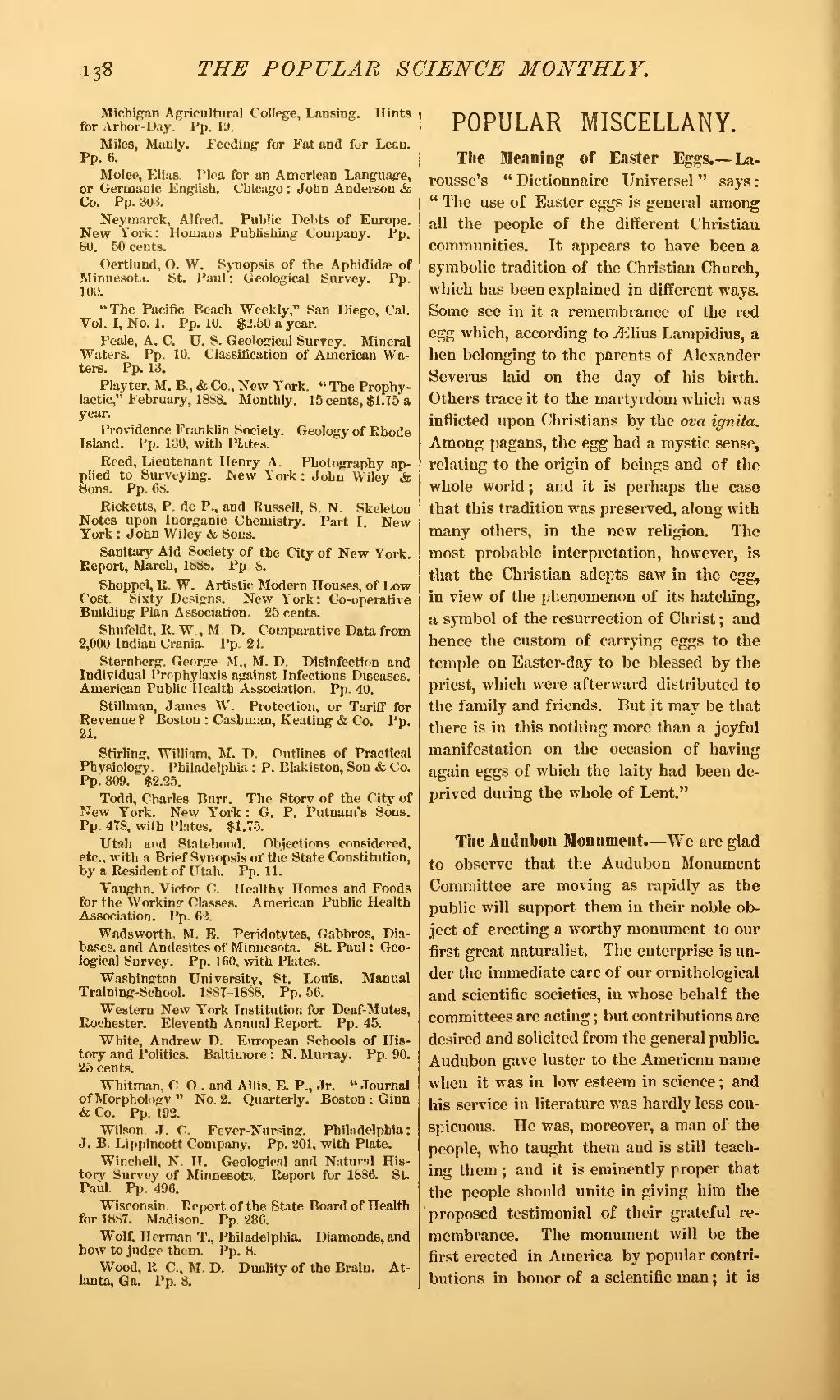Michigan Agricultural College, Lansing. Hints for Arbor-Day. Pp. 19.
Miles, Manly. Feeding for Fat and for Lean. Pp. 6.
Molee, Elias. Plea for an American Language, or Germanic English. Chicago: John Anderson & Co. Pp. 303.
Neymarck, Alfred. Public Debts of Europe. New York: Homans Publishing Company. Pp. 80. 50 cents.
Oertlund, O. W. Synopsis of the Aphididæ of Minnesota. St. Paul: Geological Survey. Pp. 100.
"The Pacific Beach Weekly," San Diego, Cal. Vol. I, No. 1. Pp. 10. $2.50 a year.
Peale, A.C. U.S. Geological Surrey. Mineral Waters. Pp. 10. Classification of American Waters. Pp. 13.
Playter, M. B., & Co., New York. "The Prophylactic," February, 1888. Monthly. 15 cents, $1.75 a year.
Providence Franklin Society. Geology of Rhode Island. Pp. 130, with Plates.
Reed, Lieutenant Henry A. Photography applied to Surveying. New York: John Wiley & Sons. Pp. 68.
Ricketts, P. de P., and Russell, S. N. Skeleton Notes upon Inorganic Chemistry. Part I. New York: John Wiley & Sons.
Sanitary Aid Society of the City of New York. Report, March, 1888. Pp 8.
Shoppel, R. W. Artistic Modern Houses, of Low Cost. Sixty Designs. New York: Co-operative Building Plan Association. 25 cents.
Shufeldt, R. W., M.D. Comparative Data from 2,000 Indian Crania. Pp. 24.
Sternberg. George M., M.D. Disinfection and Individual Prophylaxis against Infections Diseases. American Public Health Association. Pp. 40.
Stillman, James W. Protection, or Tariff for Revenue? Boston: Cashman, Keating & Co. Pp. 21.
Stirling, William, M.D. Outlines of Practical Physiology. Philadelphia: P. Blakiston, Son & Co. Pp. 309. $2.25.
Todd, Charles Burr. The Story of the City of New York. New York: G. P. Putnam's Sons. Pp. 478, with Plates. $1.75.
Utah and Statehood. Objections considered, etc., with a Brief Synopsis of the State Constitution, by a Resident of Utah. Pp. 11.
Vaughn. Victor C. Healthy Homes and Foods for the Working Classes. American Public Health Association. Pp. 62.
Wadsworth, M. E. Peridotytes, Gabbros, Diabases, and Andesites of Minnesota. St. Paul: Geological Survey. Pp. 160, with Plates.
Washington University, St. Louis. Manual Training-School. 1887-1888. Pp. 56.
Western New York Institution for Deaf-Mutes, Rochester. Eleventh Annual Report. Pp. 45.
White, Andrew D. European Schools of History and Politics. Baltimore: N. Murray. Pp. 90. 25 cents.
Whitman, C. O. and Allis. E. P., Jr. "Journal of Morphology" No. 2. Quarterly. Boston: Ginn & Co. Pp. 192.
Wilson. J. C. Fever-Nursing. Philadelphia: J. B. Lippincott Company. Pp. 201, with Plate.
Winchell, N. H. Geological and Natural History Survey of Minnesota. Report for 1886. St. Paul. Pp. 496.
Wisconsin. Report of the State Board of Health for 1887. Madison. Pp, 236.
Wolf, Herman T., Philadelphia. Diamonds, and how to judge them. Pp. 8.
Wood, R. C, M. D. Duality of the Brain. Atlanta, Ga. Pp. 8.
POPULAR MISCELLANY.
The Meaning of Easter Eggs.—Larousse's "Dictionnaire Universel" says: "The use of Easter eggs is general among all the people of the different Christian communities. It appears to have been a symbolic tradition of the Christian Church, which has been explained in different ways. Some see in it a remembrance of the red egg which, according to Ælius Lampidius, a hen belonging to the parents of Alexander Severus laid on the day of his birth. Others trace it to the martyrdom which was inflicted upon Christians by the ova ignita.
Among pagans, the egg had a mystic sense, relating to the origin of beings and of the whole world; and it is perhaps the case that this tradition was preserved, along with many others, in the new religion. The most probable interpretation, however, is that the Christian adepts saw in the egg, in view of the phenomenon of its hatching, a symbol of the resurrection of Christ; and hence the custom of carrying eggs to the temple on Easter-day to be blessed by the priest, which were afterward distributed to the family and friends. But it may be that there is in this nothing more than a joyful manifestation on the occasion of having again eggs of which the laity had been deprived during the whole of Lent."
The Audubon Monument.—We are glad to observe that the Audubon Monument Committee are moving as rapidly as the public will support them in their noble object of erecting a worthy monument to our first great naturalist. The enterprise is under the immediate care of our ornithological and scientific societies, in whose behalf the committees are acting; but contributions are desired and solicited from the general public. Audubon gave luster to the American name when it was in low esteem in science; and his service in literature was hardly less conspicuous. He was, moreover, a man of the people, who taught them and is still teaching them; and it is eminently proper that the people should unite in giving him the proposed testimonial of their grateful remembrance. The monument will be the first erected in America by popular contributions in honor of a scientific man; it is
